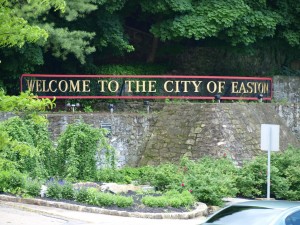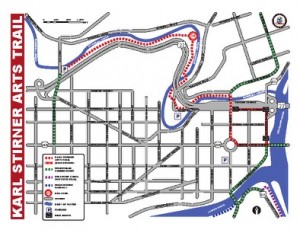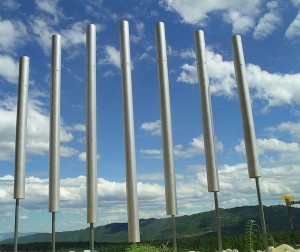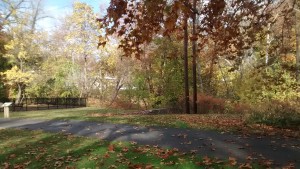Introduction

The Karl Stirner Arts Trail (KSAT), named after sculptor Karl Stirner, aims to provide not only a safe place for exercise, but also an environment that promotes and encourages art in its many forms. Towards that goal, the KSAT Board installs new sculptures or artwork along the trail periodically. German-born and from Philadelphia, Karl Stirner began his art career at age 23. He served as an industrial designer in WWII before holding teaching positions at Temple University and Moore and Swarthmore Colleges. In 1983 he moved to Easton and has since been a prominent figure in promoting art within the community. In 2011, to acknowledge his years of mentorship, the trail was renamed in his honor. Today the trail is regularly used by residents of Easton and the students of Lafayette College alike. Lafayette College is a private four-year college which sits atop the hill around which a section of the trail runs. A picture of the current trail is featured below (Figure 2), indicated by the red dotted line. The paw indicates a dog park situated along the trail.

The goal of the Karl Stirner Arts Trail is two fold. Its first goal, as mentioned above, is to promote art in its many forms. Currently, the trail is home to many sculptures placed along the edges of the trail and paintings on its walls. While the visual artistic aspect of the trail is apparent, there is no mode for auditory forms of expression. The second goal of the trail is to provide a civic space for residents of Easton to sit and enjoy together. In order to meld these two goals, as well as provide a mode for auditory forms of expression, the KSAT Board desires to implement a musical playground along the trail.

For more information about the Karl Stirner Arts Trail, please visit the KSAT homepage.
Looking for innovative ways to implement a musical playground along the KSAT to further promote the many forms of art and inspire the community, the KSAT Board enlisted the assistance of a team of students from Lafayette College to create a feasibility study for the project. This team, composed of four seniors from the Engineering Studies Department, used their training in business and engineering to assess the options of equipment to install. The purpose of the feasibility study is to recommend certain instruments to be installed at the musical playground that will be socially, politically, economically, and technically feasible, discussions of which can be found on their respected pages. In the spring of 2016, Lafayette College’s Engineering Studies 480: Sustainable Solutions class will use the feasibility study to purchase and install the musical instruments.

Instrumental in the feasibility study is Jim Toia, the head of the KSAT Board and faculty member in the Art Department at Lafayette College. Jim Toia outlined the goals of the musical playground, which consist of civic space and maintaining the art theme. The idea of the playground was born out of the desire to create more civic space for Easton residents. Though the KSAT is a great location for walking, running, and biking, there is no community location along the trail, besides the dog park, where once can stop and sit, chatting and appreciating the art with others. The playground would provide a space to do so. Instead of simply installing a pavilion, slides, and swings, however, the KSAT Board decided to only install equipment that promotes the art theme of the trail. This means, that when choosing instruments, the focus needs to be aesthetics. The KSAT Board wants to create an aesthetically pleasing space for the residents of Easton to gather, giving art precedence over functionality. The ideal arrangement will consist of instruments that not only please the eye, but also the ear, and is to be located on the plot of land directly next to the dog park, shown below.

Unlike many construction projects, selecting and installing the musical equipment has few limitations besides the importance of a civic space and eye appeal. One technical challenge, however, lies in the amount of space allotted, which is a single area of 1,000 square feet. Given that space, a balance had to be found between the size of the instruments and number installed. Each piece of equipment requires adequate open space around it to ensure smooth movement between and around the structures, yet enough instruments had to be purchased to cater to groups using the musical playground simultaneously. On the economic side, a generous budget is available for the the purchasing and installing of the equipment as the Easton Parks Department is planning to partly finance this project with monies left over from another project. They were willing to match whatever amount can be collected from other donors and organizations up to a total budget of $60,000 to $70,000. This allotment will need to cover not only the purchasing and installation of the instruments, however, but also any brush clearing, ground leveling, and surface covering. Fortunately, the class scheduled to install the musical playground in the spring can perform most, if not all, of the manual labor, allowing the budgeted monies to be spent primarily on equipment and supplies, which in addition to the instruments, will include garden stones and cement.
To read about the social, political, technical and economic contexts framing this project, please navigate using the tabs above or the links provided below:
